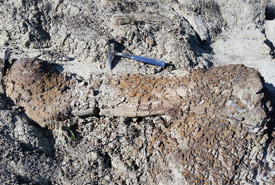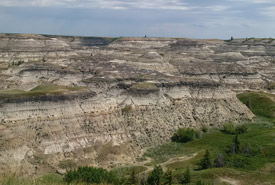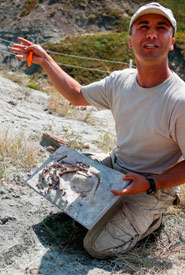Dinosaurs to the rescue! How paleontology can inform us about the necessity of conservation

A large hadrosaur femur (duckbilled dinosaur thighbone) discovered near a NCC property in Alberta. (Photo by François Therrien)
Dinosaurs are more than just scary monsters featured in Hollywood blockbuster movies; they’re the poster children for the science of paleontology, and one of the best subjects to educate the general public about natural history.
Dinosaurs ruled the Earth for nearly 165 million years (from 230 million years ago until 66 million years ago). If we include birds, dinosaurs would be considered to rule the Earth to this day. They represent one of life’s greatest success stories, having lived through and survived the consequences of countless environmental and climatic changes, including massive volcanic eruptions, the breakup of continents as well as the collision of land masses to form huge mountain belts. Consequently, the study of dinosaurs, and of the myriad animals and plants that lived alongside them, can inform us about how ecosystems respond to periods of change.
Whether they be catastrophic or gradual, dinosaurs provide us with context and perspective when attempting to understand the possible ecological consequences of human-made and natural changes that our world is facing today. Through paleontology, it’s possible to educate the public about the necessity of conservation.
Fossil records tell us that animal and plant species don’t last forever; eventually they will go extinct (more than 99 per cent of all life forms that have ever lived on Earth are now extinct). While most extinctions occur gradually and regionally as species evolve into or are replaced by new ones (known as “background extinctions”), there are 18 time intervals over the course of the past 600 million years when species went extinct rapidly and globally. These are called mass extinctions, and are responsible for the disappearance of vast numbers (sometimes more than 80 per cent) of life forms that were present on Earth at the time.
Although the exact mechanisms responsible for the disappearance of large numbers of species are often the subject of scientific debate, mass extinctions appear to occur with episodes of major environmental upheaval.

Horseshoe Canyon (Photo by NCC)
Mass extinctions are often followed by extended periods, some lasting millions of years, of low biodiversity and highly unstable ecosystems. As such, these extinction events are most informative about the sensitivity and response of various species to environmental change and the amount of time required for ecosystems to recover once destabilized. For example, we learned that species characterized by limited geographic distribution, narrow habitat preferences and slow reproductive rates are more susceptible to becoming extinct.
We also learned that during periods of rapid global warming, such as during the Paleocene-Eocene transition 55 million years ago, surviving mammal species shrank dramatically in size compared to their ancestors. And in instances of food web collapses, such as what happened at the end of the Age of Dinosaurs 66 million years ago, cold-blooded animals with a small body size (weighing less than 20 kilograms) that have a scavenging diet and live in close association with water bodies are more likely to survive than large, warm-blooded animals with a specialized diet (such as herbivores and carnivores).
Following the extinction of dinosaurs, while it took only around 5,000 years for forests to recover from the devastation caused by the meteorite impact, it took nearly 1 million years for mammals to recover and nearly 4 million years for marine ecosystems to return to normal.
Knowing how ancient ecosystems responded to past environmental crises and what species suffered extinction can guide us in our efforts to develop effective conservation policies and to determine what habitats should be protected to conserve long-term biodiversity in light of modern environmental disturbances.
While paleontology can assist with conservation, the reverse is equally true. Numerous fossil zones occur in highly scenic landscapes, such as those in the Alberta badlands. With expanding urban development and industrialization, many fossil areas are at risk of being destroyed or greatly reduced in size. This is where the role of conservation can be expanded to protect the paleontological resources preserved in the ground in these areas.
The protection and conservation of paleontological resources shouldn’t mean that fossils and the outcrops that encased them should be left undisturbed for the force of erosion to take its natural course, resulting in the loss of valuable knowledge about past organisms and ecosystems. Rather, conservation would allow for the excavation of fossils to be conducted in a responsible and respectful fashion that minimizes adverse effects on the local ecosystem. With such a balanced approach, paleontology and conservation can mutually benefit each other.


